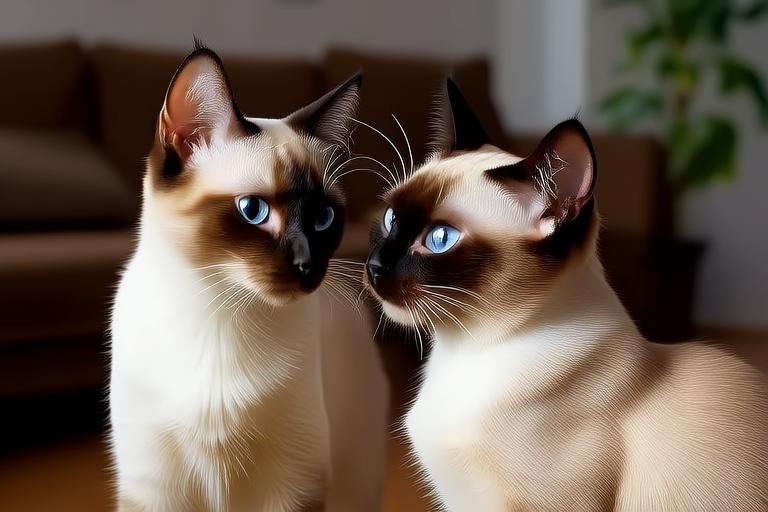
Unveiling the Mysterious World of Siamese Cats: A Complete Guide
The Siamese cat, with its striking blue almond-shaped eyes and sleek coat, has long captivated the hearts of cat enthusiasts worldwide. Known for their distinctive physical traits and engaging personalities, these felines have earned a reputation as one of the most popular and recognizable breeds. This comprehensive guide delves into the fascinating world of Siamese cats, exploring their history, unique characteristics, care requirements, and why they make such wonderful companions.
Unique Physical Traits and Distinct Personalities
Siamese cats are instantly recognizable due to their pointed coloration, which means that their extremities – ears, paws, tail, and face – are darker than the rest of their body. The classic seal point coloring, where the points are dark brown, is the most common, but other variations include chocolate, blue, and lilac points. Their coats are short, fine, and glossy, requiring minimal grooming. However, it’s their expressive faces and piercing blue eyes that truly set them apart.
Besides their stunning appearance, Siamese cats are known for their extroverted and social personalities. They are often described as ‘dog-like’ in their loyalty and affection towards their human companions. Siamese cats are highly intelligent and curious, always eager to explore their surroundings. They enjoy being part of family activities and thrive on interaction, making them less suited for households where they will be left alone for extended periods.
A Brief History of Siamese Cats
The origins of the Siamese cat can be traced back to Thailand (formerly Siam), where they were considered sacred and often kept in temples or the royal palaces. It is believed that they were selectively bred to enhance their striking appearance and vocal communication. The first Siamese cats arrived in Britain in the late 19th century, brought by a British diplomat who was charmed by the breed’s exotic beauty. These early imports quickly gained popularity among the upper classes, and soon, Siamese cats began to spread across Europe and North America.
Over time, selective breeding has refined the Siamese breed, leading to two main varieties: the traditional and the modern. Traditional Siamese cats retain more of the breed’s original features, including a rounder head and thicker bodies. In contrast, modern Siamese cats have been bred to be more slender and have longer, narrower heads, giving them an elegant and almost alien-like appearance.
Vocal Nature and Intelligence
One of the most distinctive traits of Siamese cats is their vocal nature. They are known to be very talkative and will often ‘speak’ to their owners, meowing, chirping, and even trilling. Some Siamese cats can be quite demanding, especially when they want attention or food. This vocalization is not just limited to humans; they also communicate with each other through various sounds. Their intelligence allows them to learn tricks and respond to commands, making training sessions both fun and rewarding for both the cat and owner.
Siamese cats are also known for their problem-solving abilities. For example, if a door is slightly ajar, they will figure out how to push it open to gain access. They are incredibly observant and can easily adapt to new environments, making them excellent travelers. Their intelligence, combined with their social nature, makes them ideal pets for families who are active and spend a lot of time at home.
Proper Care and Dietary Needs
Caring for a Siamese cat involves meeting their grooming, exercise, and dietary needs. Despite their short coats, Siamese cats benefit from regular brushing to remove loose hair and distribute natural oils. This helps maintain the shine and health of their coat. Additionally, their nails should be trimmed regularly to prevent overgrowth, and their teeth should be checked and cleaned to avoid dental issues.
Dietary needs for Siamese cats should focus on high-quality protein sources to support their active lifestyle. Wet food is recommended as it provides necessary hydration and can help manage weight. Dry food can be given in moderation to promote dental health. It’s important to consult with a veterinarian to determine the appropriate amount and type of food based on the cat’s age, activity level, and overall health.
Common Health Issues
While generally healthy, Siamese cats can be prone to certain genetic conditions. One of the most common is Progressive Retinal Atrophy (PRA), a degenerative eye disease that can lead to blindness. Regular eye exams can help detect this condition early. Another issue is cardiomyopathy, a heart condition that affects the muscle tissue of the heart. Genetic testing and routine veterinary check-ups are crucial for early detection and management of these conditions.
Siamese cats may also suffer from dental problems due to their small mouths and crowded teeth. Proper dental care, including brushing and professional cleanings, is essential to maintain their oral health. Obesity is another concern, particularly in older cats, so monitoring their diet and ensuring adequate exercise can help keep them fit and healthy.
Why Siamese Cats Make Great Companions
The Siamese cat’s unique combination of beauty, intelligence, and affection makes them exceptional companions. Their loyalty and desire for interaction create a strong bond between cat and owner. They are playful and enjoy interactive toys, which can stimulate their minds and keep them entertained. Siamese cats are also known for their protective instincts, often acting as watchdogs for their families.
For those considering adopting a Siamese cat, it’s important to understand their need for companionship and mental stimulation. Providing them with plenty of attention, toys, and playtime will ensure they remain happy and well-adjusted. Potential owners should also be prepared for the possibility of vocal demands and the need for consistent grooming. With the right care and attention, Siamese cats can provide years of joy and companionship.
Tips for Potential Owners
When bringing a Siamese cat into your home, it’s important to prepare adequately. Create a safe, stimulating environment that includes scratching posts, climbing structures, and plenty of hiding spots. Gradually introduce them to new environments to minimize stress. Establish a routine for feeding, play, and grooming to provide structure and predictability.
Training is another key aspect of raising a Siamese cat. Positive reinforcement techniques, such as treats and praise, can be used to teach basic commands and discourage unwanted behaviors. Socialization is also crucial, especially during the kitten stage, to ensure they grow up to be friendly and adaptable adults.
In conclusion, Siamese cats are a fascinating and rewarding breed that offers a unique blend of beauty, intelligence, and companionship. Understanding their history, needs, and behaviors will help you provide the best care possible and ensure a lifelong bond with your feline friend. Whether you’re a seasoned cat owner or considering adopting your first Siamese, this guide provides valuable insights into the mysterious world of these enchanting creatures.






